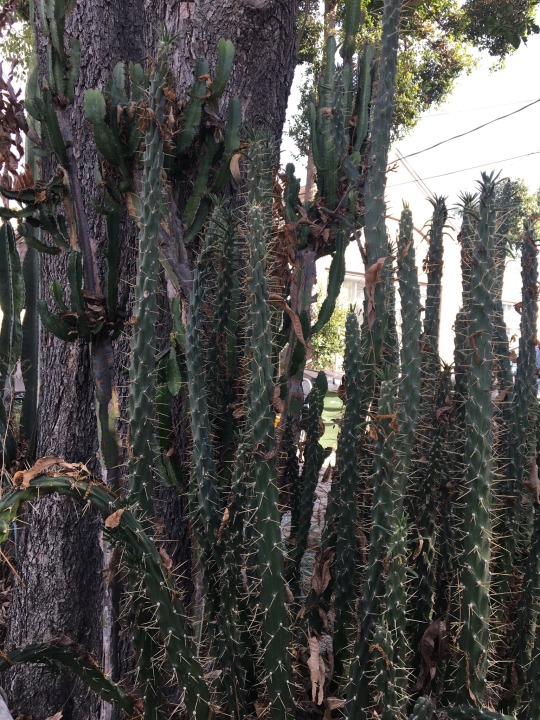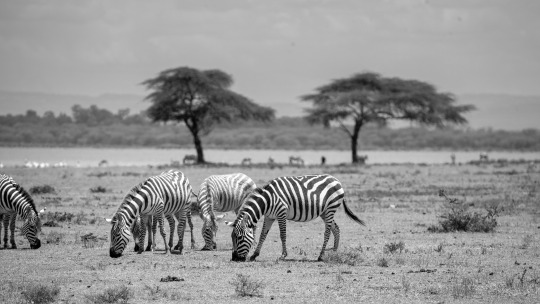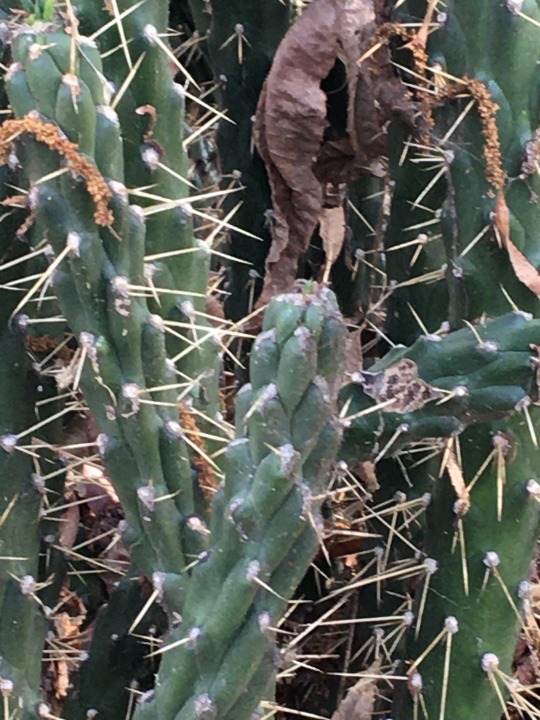#opuntia subulata
Explore tagged Tumblr posts
Text

This one was only meant to be grafting practice (self-grafting, specifically) but now I am calling it Étude in Austrocylindropuntia subulata 003: "Zigged when I shoulda zagged" because I am a real sucker for long titles. Still needs suitable potting and possibly a companion plant. Open to suggestions. (A. subulata is a South American relative of the more widely known prickly pear, genus Opuntia, which is notable for retaining leaves beyond the seedling stage, although they are still drought-deciduous and so tend to remain only on new growth. It also grows impressively in the less-than-ideal lighting I give it and does not seem to mind being chopped up as long as it gets put back together.)
3 notes
·
View notes
Note
Favorite plant? or like maybe top 5?
It seems like a copout answer to just say all of them so I'll give you five in no specific order (below the cut)
Colobanthus quitensis, also known as Antarctic pearlwort. It's one of two known flowering antarctic plants (the other being Antarctic hair grass), it was discovered in the late 1700's-early 1800's. Since Antartica is a dessert it's native plants have a special kind of leaf structure to account for the lack of rainfall.
Cornus florida, or the flowering dogwood. It's native to North America and Mexico, the trees are monoecious meaning that it has both male and female flowers. It also serves as a place for more then 12 species of moths to lay their larvae in.
Phlox subulata, or moss phlox. It's an pink, purple, blue, or white evergreen native to the united states that commonly covers ground in wooded areas. It also serves as a pollinator and can be used to prevent erosion.
Pinus strobus, or the eastern white pine tree. These trees have been known to live for over 400 years and are largely considered the tallest trees in eastern North America. They also serve as habitats for other plants along with animals and insects.
Opuntia, also known as the prickly pear cactus. I had to include some sort of cacti in this because they are so vital to the ecosystem and water cycle. The prickly pear cactus in particular are some of the most cold tolerating cacti, and like many other cacti are only native to the Americas.
#this is just turning into a plant blog for me#which im ok with#feel free to keep asking about plants#ooc: this did take like half an hour to write and research though/lh#pamela isley#poison ivy#ask ivy#dc rp blog#dc rp#dc#dc comics#gotham rogues#plants
3 notes
·
View notes
Photo



I’m officially home after finishing my third year in uni and I’m so happy to have -almost- all my children together (i still cant identify three of them tho)
#cacti#cacti collection#succulent#succulents#succulent love#succs#succulent propagation#cactus#cactilove#cacti and desert plants#echinopsis subdenudata#opuntia subulata#echeveria setosa#crassula rupestis#haworthia attenuata#echinocereus reichenbachii#aeonium decorum#gasteria variegata#opuntia microdasys#honckenya peploides#echeveria prolifica#euphorbia ritchiei#propagation#props#propagating#leaf propagation#crassula propagation#seashells#mine
214 notes
·
View notes
Text


7 notes
·
View notes
Photo

This thing looks so alien and I love it! Opuntia subulata. Gonna need a proper pot for it soon. by Krosis97
23 notes
·
View notes
Text


Experiment 626 👽
Opuntia subulata monstrose ‘Gumby’ (11/29/19
18 notes
·
View notes
Photo


It’s springtime! Which means my outdoor cactuses can resume growth! One of the Opuntia engelmannii var. texana plants that I sowed 6 years ago during college has put out another stem bud! Which makes it my oldest plant, if you don’t count the Hatiora cutting from my family, though I’ve chopped my cactus back quite a bit for moving purposes so idk if this is even an original root segment The spiky-looking organs surrounding the new growth are actually rubbery conical leaves! Opuntia and Opuntioids are some of a couple of cactuses that have visible non-spiny leaves at some point of their lives. Unlike Pereskia or Pereskiopsis, these leaves end up dropping off eventually and only show up on new growth for most Opuntia, although there are a few varieties I’ve seen that keep them for much longer! Austrocylindropuntia subulata comes to mind.
I’m hoping I can get this one to flower someday!
82 notes
·
View notes
Photo

7-17-19
Opuntia Subulata, Penwiper Plant, Euphorbia Schinzii, Paper Spine Cactus
I got these all from the same store, thought they looked cool. The cacti are going to get really big hopefully.
4 notes
·
View notes
Photo

Mi nueva adquisición: Opuntia subulata cristata Las formas de cresta, generalmente ocurren cuando se produce una lesión en la planta a una edad temprana, este daño puede deberse a que los insectos comen la punta en crecimiento o por muchas otras causas, incluida una predisposición genética. En reacción a esa “lesión”, las células en la punta de la rama, donde se produce el crecimiento, comienzan a multiplicarse a un ritmo mucho más rápido y la punta de crecimiento normal “se vuelve loca”, como decimos más arriba. #cactisucculents #opuntia #Cristata #Artjoseanespi #photos #fotografiaartistica #photographs #Bizkaia #fotomovil https://www.instagram.com/p/COYt7q8gZS7/?igshid=psma7o5tgemn
#cactisucculents#opuntia#cristata#artjoseanespi#photos#fotografiaartistica#photographs#bizkaia#fotomovil
0 notes
Photo

1 note
·
View note
Text
An important assessment of invasive plants in Kenya

- By CABI -
CABI (Centre for Agriculture and Bioscience International) scientists have led the first assessment of naturalised, invasive and potentially invasive plant species present in Laikipia County, Kenya, which hosts the highest populations of endangered large mammals in the country.
The research led by Dr Arne Witt suggests that a range of invasive alien plants pose a series risk to the County – home to the second-highest number of endangered wildlife in East Africa including elephant, rhino, Grevy’s zebra, reticulated giraffe and wild dogs.
Together with CABI colleagues Winnie Nunda and Tim Beale along with help from Dr Darren Kriticos of the University of Queensland, Australia, Dr Witt argues that without efforts to eradicate, contain, or control invasive plant species in Laikipia County many rare and iconic wildlife species may be lost.
As outlined in the journal Koedoe: African Protected Area Conservation and Science, the researchers strongly advocate the use of biological controls as cost effective, safe and environmentally sustainable ways to manage some of the invasive plants as part of an integrated management plan.
Broadscale roadside surveys were carried out in Laikipia County, to record all naturalised and invasive species. This data was supplemented by CLIMEX eco-climatic niche models of nine species that the scientists consider to pose the biggest threat to conservation initiatives in the East African region.
Widespread species in the County included Opuntia stricta, O. ficus-indica, Austrocylindropuntia subulata and other succulents. Of the 145 alien plant species recorded, 67 and 37 (including four species of uncertain origin) were considered to be already naturalised or invasive, respectively, and a further 41 species had been recorded as being naturalised or invasive outside of Laikipia. Most (141) of these species were introduced as ornamentals only or had uses in addition to being ornamentals, with the majority (77) having their origins in tropical America.
Based on the current eco-climatic conditions, most of Laikipia is unsuitable for Chromolaena odorata, marginally suitable for Mimosa pigra and Lantana camara, and a better climatic match, ranked from least to most favourable, for Tithonia diversifolia, Cryptostegia grandiflora, Parthenium hysterophorus, Prosopis juliflora, O. stricta, and Parkinsonia aculeata.
Dr Witt said, "The County is home to the second-highest abundance of wildlife in East Africa, after the Mara-Serengeti ecosystem, and hosts the highest populations of endangered large mammals in Kenya.
"Alien plant invasions pose significant threats to conservation and livelihoods in Laikipia. As such, it would be prudent to develop and implement management strategies to reduce the threats of all invasive and potentially invasive plant species.
"It is imperative that all naturalised, invasive and potentially invasive plant species be removed from the grounds of all tourist facilities and possibly also villages that fall within areas where the main land-use practice is livestock production and conservation.

Diagram: Maps showing the distribution of nine of the most widespread invasive plant species in Laikipia County, Kenya. Credit: Koedoe: African Protected Area Conservation and Science.
"Those plants which have already escaped cultivation should be eradicated, if possible, or their further spread contained. Finally, biological control solutions for widespread and abundant species should be implemented wherever possible, as has been done for O. stricta and initiated for O. engelmannii."
Dr Witt added that there are many benefits to the use of biological controls including the fact that many agents establish self-perpetuating populations, often across the whole range of the target species, and most projects only require a one-off investment.
"There are a number of widespread and abundant invasive plant species in Laikipia that could be targeted for biological control," he said. "The cochineal Dactylopius opuntiae (Cockerell) 'stricta' biotype (Dactylopiidae), recently introduced for the control of O. stricta, is already established in Laikipia. Species such as O. ficus-indica and O. monacantha have also been brought under good control through the introduction of cochineal in the last century."
Permission is currently being sought from the regulatory authorities to introduce another biotype of D. opuntiae for the control of O. engelmannii. Cereus jamacaru has also been brought under good biological control in South Africa, an option should this species become invasive, although populations are currently such that it can still be eradicated in Laikipia.
--
Source: CABI
Full study: “A preliminary assessment of the presence and distribution of invasive and potentially invasive alien plant species in Laikipia County, Kenya, a biodiversity hotspot”, Koedoe: African Protected Area Conservation and Science.
http://dx.doi.org/10.4102/koedoe.v62i1.1605
Read Also
Amazon forest: Disturbance is changing how plants are dispersed
0 notes
Photo

Opuntia,Gumbi Subulata Monstrose Cactus https://www.instagram.com/p/ByTcGelF49K/?igshid=1d4cpj3xuoitr
0 notes
Photo

Opuntia subulata im Straßenbegleitgrün 😉 Zugegeben - verkehrssicher geht anders - aber in jedem Fall besonders. Streets of Gibraltar 🇬🇮 #kakteenhaage #kaktusgaertner #Blumenstadt #kaktusgaertner #gärtnersein #haageontour #haagelife (hier: Gibraltar, United Kingdom) https://www.instagram.com/p/Bv9uE6AFaEd/?utm_source=ig_tumblr_share&igshid=cy7kd7y1zz0z
0 notes
Photo

pot buddies! (Open for better quality)
#opuntia#opuntia subulata#echinopsis#echinopsis subdenudata#cactus#cacti#cactuslover#cactilove#cacti and desert plants#cactus blog#mine
73 notes
·
View notes
Photo

Just Pinned to cactus garden: Opuntia Subulata : Cactus y Suculentas de Amanecer http://bit.ly/2Hd7gHM
0 notes


